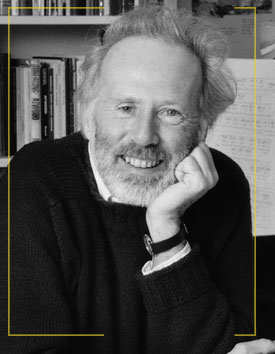 R. Murray Schafer – Snowforms (1982) – for treble choir
R. Murray Schafer – Snowforms (1982) – for treble choir
The text consists of inuit words for various kinds of snow : apingaut , first snowfall; mauyk, soft snow; akelrorak , drifting snow ; pokaktok , snow like salt.
Notes from the composer:
In 1971 I flew the polar route from Europe to Vancouver over Greenland. Clear weather provided an excellent opportunity to study the forms of that spectacular and terrifying geography. Immediately, I had an idea for a symphonic work in which sustained bulks of sound would be fractured by occasional splinters of colour. That experience remains clear in memory. It suggested the orchestral textures of “North/White” and it returns now to shape “Snowforms”, yet very differently, for my memory of the vast foldings of Arctic snow has been modified by the experience of passing winters in Ontario. Often on a winter day I have broken off from other work to study the snow from my farmhouse window, and it is the memory of these forms which has suggested most of the continuous horizon of “Snowforms “.
Sometimes I have given children ‘sight-singing’ exercises in which they are asked to ‘sing’ drawings or the shapes of the distant horizon. Snowforms began as a series of sketches of snowdrifts, seen out the window of my Monteagle Valley farmhouse. I took these sketches and traced a pentagram over them. The notes of the pieced emerged wherever the lines of the sketch and the stave crossed. Of course I modified the drawings as necessary since the work is primarily a piece of music and only secondarily a set of sketches. I printed the work so that the shapes of the snow were in white over a pale blue background.
The entire piece is soft, and I wanted the voices to slide from note to note just like falling or drifting snow. Snowforms is related to Epitaph for Moonlight, Miniwanka and Sun ; they are all descriptions of nature. Later I was to add Fire, A Garden of Bells and Once on a Windy Night as further celebrations of natural phenomena. As the urban populations of the world grow, the forces and charms of nature are more distanced from increasing numbers of people. But I do not write such works out of nostalgia; they are a very real part of my life. Snowforms was actually preceded by a much more complex work of the same name which was performed once by the Vancouver Chamber Choir, but I am glad I withdrew it, substituting this simpler and purer expression of one of nature’s most beautiful elements.
Notes from co-conductors :
This 20 th century monument of treble choral literature was written in 1982 by the imaginative, highly respected, internationally praised composer, R. Murray Schafer. Watching from his farmhouse window in Ontario , Schafer was intrigued by the various shapes, forms, and ever-changing, soft foldings of snow. From these observations came the inspiration to write Snowforms. Using graphic notation, he asks singers to sing ‘shapes’ or ‘drawings’ which are representations of snow forms on the distant horizon. Schafer’s graphic notation is augmented by suggested pitches and the voices are asked to ‘glide’ from one pitch to another in a continuous portamento. A time log is written in the score to suggest durations but Schafer is quite specific that conductors should not feel ‘enslaved’ by the timed suggestions. Although it was written for two part treble chorus, there are a few times within the score when each of the two parts split into four independent lines. Except for the occasional interjection of words which mean various types of ‘snow’ in the Inuit language the entire piece is hummed thereby giving a sense of smoothness and peaceful quietness or hush. Challenges for the conductor are to find gestures that suggest and mirror the contours that are found within the score. Challenges for the singers are to believe the piece will ‘work’ and to trust the instincts and imagination of not only the composer and conductor but also of themselves. Snowforms is a remarkable work that fascinates listeners but more importantly encourages collaboration and exchange of ideas between conductors and singers. It encourages performers to create music beyond the bounds of a traditional score with very satisfying results. – DL
